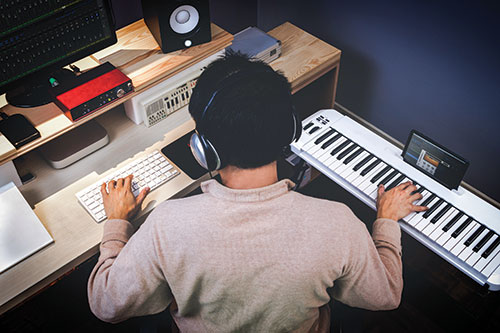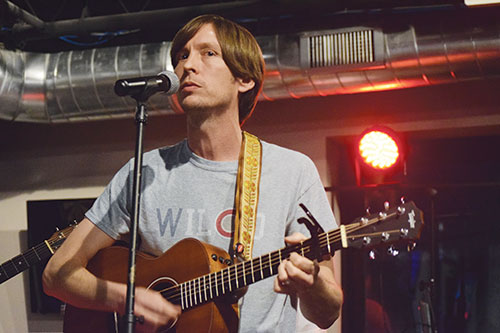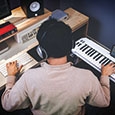With roots going back to one iMac computer purchased by the band director in 2008, the York Community High School (Elmhurst, Illinois) music production program guided by Chris Gemkow has grown into a home for students to make music together, complete with an after school club and multiple album projects. We chatted with Gemkow about his approach to this often overlooked area of music.

The Start of the Program
Writing songs and playing guitar was a hobby for me. I started my career at York Community High School as a special ed English teacher. During my first two years at York, I established a friendship with Performing Arts Department Chairman Bill Riddle and Band Director Mike Pavlik, and when a guitar teacher position opened up, I switched to part-time guitar and part time special ed English.
At the same time, the music production program was just getting started. Originally the music department had one Mac for general use, which was purchased by the band director when the technology department switched the school to PCs, and that turned into five computers, then eight. With the retirement of the piano and music theory teacher, the music department converted the space into a music computer lab.
York sought a teacher who would be interested in developing a music production program. We called several college music programs across the country and eventually located a teacher from Indiana University. It was important to find a candidate who was equipped to develop this new type of program but also necessary that they would be willing to work part-time, with the potential of the position eventually evolving into a full time gig. This teacher grew the production program into a full-time position but left for a job developing video games. I was offered the music production classes and accepted before the department chairman had finished asking the question.
I had been recording my songs for years and had experimented with recording technology, from a Tascam four-track to digital recorders that let you layer 32 tracks, but the first couple years were a crash course in learning the software. At the same time, I had inherited the class when dubstep was at its peak, so most of the students were interested in emulating artists like Skrillex and Deadmau5, when I had always been more into Wilco, Bob Dylan, and The Beatles. I worried that all the students would be disappointed that I wasn’t an expert in electronic music. In the end, my approach was to make the class something students with no musical knowledge could take and learn to do something new. This is still my approach.
Some of my students come from band, orchestra, and choir. Others are the type who might never have taken a music class in high school if not for production. They want to get together and jam with their friends and write their own music in the process. My goal is to help these students channel their desires into creating some music.
Curriculum
We have three tiers of music production classes, each lasting a semester. Music Production I is an introduction to using a computer to create music. We teach students how to use Logic Pro X but emphasize that this is not a Logic Pro X class. The program is simply a tool to make music.
Students come into the class with a wide variety of experiences, but the aim is to show them all how to put together a song. Students already know the elements of music – melody, harmony, a bass line, a percussion part – even if they cannot define these formally. They just need to have these things pointed out.
Keyboards can be intimidating to a student who cannot play piano, so I approach teaching keyboard as a big remote control that can be a drum machine or a horn section. Students learn some basic keyboard skills with the mindset that they are programming a sequence of keystrokes that will trigger sounds in the program.
At this basic level, I want students to feel comfortable opening a project and have fun making music. Some students take the class because they have to take something. Others come in and discover that this is exactly what they have wanted to do with music and that these tools are perfect for expressing themselves. One of my students also plays in the orchestra, but after taking the music production classes, she is going to college to major in audio engineering.
Music Production II allows students to discover their voice. They have learned to use the tools they need, and the next step is to use those tools to express themselves. The big projects for this class is to use lyrics in some way. Some students have little trouble writing and performing their own words without any self-consciousness, but this is not the case for many others. When they express fear of sharing lyrics, I ask what kind of music they like. It always has lyrics in it.
Students do not need to use lyrics they have written. Ben Harper has a song called I’ll Rise, for which he converted Maya Angelou’s poem Still I Rise to a song, and students are welcome to set someone else’s words to music if they prefer. I still nudge them toward writing for themselves, though.
The bulk of Music Production III is devoted to what we call the EP project. Each student has to write a collection of three to five original songs with an overarching concept. Students can work independently or team up, but each student is required to contribute at least three songs. This semester I have a trio teaming up; they are going to have to write a full album of at least nine songs.
Students present ideas to the class. Some of these will be finished songs, others will be bare-bones ideas. I have had students write lyrics and melody during first period, record vocals during second period, and present it during fourth period. Other students in the class offer suggestions and feedback on possible additions or changes. All student work gets submitted to Google Classroom, so it is easy for students to call up their projects on any computer. Students in Music Production III have a great deal of independence, but my job is to keep them within a large boundary to explore ideas and find out where they want to go with this.
Collaboration is also an important part of the class. It is required to work with other people to record your songs. This is not limited to people in the class. Anyone you can find to help is welcome. Presentation days tend to generate collaborative ideas, as students volunteer to add a part to someone’s song.
The project ends with the formal release. Students create a profile on bandcamp.com and upload their songs. The profile must be released to the class but can otherwise be kept private if students choose. Most of them make it public because I explain that if they want their work out there they have to market it; no one is going to find someone accidentally on bandcamp.

Chris Gemkow performs onstage at the invitation of one of his students. Photo by Helena Koczur.
Equipment
We have a dedicated Mac lab for the class. Beyond the computers themselves, you will need a digital audio workstation program. When I took over the class, we started with GarageBand before moving to Logic Pro X, but students kept wanting GarageBand to do things it could not do because it is designed to be user friendly rather than for a professional studio. Eventually we abandoned GarageBand and taught Logic Pro X from the beginning. We use Logic Pro X because that is the program for which the school has licenses, but there are other options available, including Ableton and Pro Tools. I recommend against a web-based digital audio workstation. There are interesting web-based options available, but it is better to have something local to each computer for the sake of long-term reliability.
To start, you do not need the best microphones. Eventually, the program should have something durable and reliable, but even smart phone mics work. In Music Production I, one project is recorded entirely through smart phone. We have eighth-inch-to-quarter-inch cables, and send sounds from the phones to Google Drive, then download them onto the lab computers. If you have ten tablets, each with a microphone, then you have ten microphones.
MIDI controller keyboards are also essential. We have 88-key models with weighted keys now, but we started with 55-key, plastic keyboards, and they worked just fine. You can teach the concepts of recording and MIDI generation without top-tier equipment.
You will also need audio interfaces – something that allows students to record through a microphone or anything with a quarter-inch connection. We can use these to upload sound files directly to the computers.
We have a recording studio that is slowly and steadily improving. The room is not soundproof, but we are getting there. This spring we installed a couple ceiling clouds for sound protection and some side panels to reduce the 90-degree angles in the room. It is expensive to completely soundproof a room, but that is the goal. We are still a few years away from finishing it.
Extracurricular Options
Our school has an after-school musicians’ club. It was originally called the Amateur Musicians Club. I inherited the group from another teacher. It started as a small gathering of 10-12 students who met after school to have jam sessions. When I transferred to teaching in the music department part time, I put out an announcement and had 60 students show up to the next meeting. I had no idea what to do with that many students, so I had them spread out and work in smaller groups.
Over time, it evolved into an open gym for musicians. They know they can just come down after school and make music. Students have the option to work on computers, but mostly they want to play. Some work privately on a recording project or write songs. Others use the space for band practice or to collaborate with a partner on something.
We have some instruments, but I encourage students to bring their own. The only rules are to be respectful of the equipment and the environment. I walk around and check in on students, listening to their work. One of the joys is hearing new songs written by students, and it started happening often enough that I wanted the club to make an album.
At this point I had started working on a master’s degree, but had not decided upon a final project yet. I had to involve students in the project, and the prospect of an 80-page research paper was unappealing, so I proposed recording an album of my students’ original material. The idea was approved, and the York Album Project was born.
At the beginning of the school year, I invited students to write and record a song to contribute to the album. Taking Music Production was not a requirement; it was an extracurricular project with CDs to be made and a release party at the end of the school year. It went better than I expected and has become an annual project now; this year will be the fifth album.
For the first few years, we worked with a sound engineer who has a studio in his garage, but now we do 90% of the recording and mixing (combining individual tracks) in house, then I send it out to get mastered (transferring the sound files to a data storage device, from which all copies will be made).
The York Album Project has also branched off into yet another project, called the LP Project. At the end of last year, I approached six different soon-to-be senior musicians and groups who were writing prolifically and encouraged them to put together full-length albums. These seniors are having a release party for this project in early April. We will have a videographer and a soundboard mix, and at the end of it all, these students will have a meaningful experience and a great memento of their work to use after high school.
Performances
There are a few performance options throughout the year. I want students to have the experience of performing a Saturday night show, but for obvious reasons, we cannot do that in a bar. There is a combination recording studio and performance venue in a nearby suburb, and we had a show there in December, and the LP Project release party will be there, too.
The first four release parties for the York Album Project were in Chicago, but we are moving it closer to home this year to entice more of the community to come. We found a local restaurant with a music venue, and the York Album Project release party will be there.
In addition, the Illinois Music Education Association has an annual composition contest. This year, in the commercial/popular category, four York students won awards – first place, two who tied for second, and one honorable mention.
The Best Part
The best part of this is that it demystifies music-making for students. Writing songs and recording music is something everyone has access to. They have the opportunity to go through every step of the process in a supportive environment. I overhear students asking each other whether they are going to contribute to the album or start their own band this year.
Students come to me almost weekly to ask if they can play me a song they wrote. I get to hear new songs that no one else has heard, and students trust me to listen and help develop their art to put out into the world.





